Which Dinosaurs are Hadrosaurs?
Table of Contents
The hadrosaurs, also known as duck-billed dinosaurs, were named after their broad, flattened, elongated snouts and toothless beaks. Their grinding teeth and cheek pouches were perfectly adapted for browsing on vegetation.
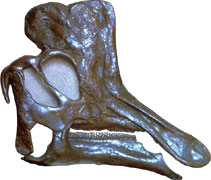 The subfamily Lambeosaurinae, which has a hollow-crest, and the subfamily Saurolophinae, which was traditionally known as Hadrosauridae, have both been recognized as having strange jaws that look very similar to a duck’s bill. Both of these have received strong support in recent literature.
The subfamily Lambeosaurinae, which has a hollow-crest, and the subfamily Saurolophinae, which was traditionally known as Hadrosauridae, have both been recognized as having strange jaws that look very similar to a duck’s bill. Both of these have received strong support in recent literature.
Lambeosaurines have traditionally been divided into Parasaurolophini and Lambeosaurini. Tsintaosaurini and Aralosaurini were discovered recently.
Anatotitan
Anatotitan was a typical hadrosaur, or duckbilled dinosaur that probably lived right up until the extinction of the dinosaurs. This animal had a long snout similar to that of a modern-day horse. Its mouth consisted of a toothless bill, with rows of teeth further back in the cheek region.
Anatotitan (“giant duck” in Greek) had nothing in common with modern ducks, despite its amusing name. This had happened. The rosaur used its broad, flat bill to nip at low-lying vegetation, which it would need to eat hundreds of pounds of every day.
The name “Duckbilled” was first applied to this dinosaur when it was discovered in 1908. Since that time, this name has been used with all the other hadrosaurs as well.
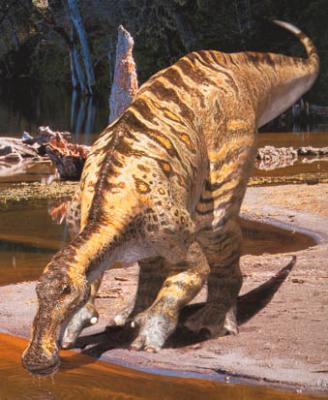
- What is this dinosaur’s name? Anatotitan
- How do I pronounce it? Ann-at-owe-tie-tann
- What does its name mean? Giant Duck
- How long was this dinosaur? 33.00 feet,10.00 meters
- How heavy was this dinosaur? 7000.00 pounds
- What class was this dinosaur assigned to? Ornithopoda
- What did this dinosaur eat? Plants
- How many years ago did this dinosaur live? 65,000,000 Years Ago
- In what period did this dinosaur live? Late Cretaceous
- Where did this dinosaur live? North America, South Dakota
Bactrosaurus
This Hadrosaur or duckbilled dinosaur lived around 95 million years ago during the Middle Cretaceous Period. Like other duckbilled dinosaurs, it had a toothless beak-shaped opening at the front of its math, with rows of self-sharpening teeth located further back in the cheek region.
It also had a line of spine-like projections along its back and tail, that probably supported a flap of skin, or muscle. This feature led to its name Bactrosaurus, which means Club-Spined Lizard.
Bactrosaurus was discovered in Asia and received its name in 1931.
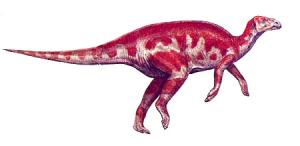
- What is this dinosaur’s name? Bactrosaurus
- How do I pronounce it? Back-troe-sore-uss
- What does its name mean? Club-Spined Lizard
- How long was this dinosaur? 20.00 feet, 6.00 meters
- How heavy was this dinosaur? 3000.00 pounds
- What class was this dinosaur assigned to? Ornithopoda
- What did this dinosaur eat? Plants
- How many years ago did this dinosaur live? 95,000,000 Years Ago
- In what period did this dinosaur live? Middle To Late Cretaceous
- Where did this dinosaur live? Uzbekistan, Asia, China, Mongolia
Corythosaurus
Living near the end of the Dinosaur age, Corythosaurus, or helmet head, was a large hadrosaur. A hadrosaur is a duck-billed dinosaur. Like other hadrosaurs it had a toothless beak, with rows of sharp teeth located in the back of its mouth.
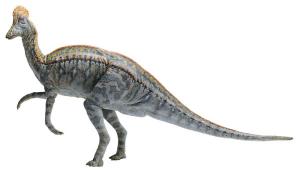 The name Corythosaurus comes from its crest, which looks like a helmet worn by ancient soldiers. This crest was probably used to make a load horn noise. Air from the animals nostrils was forced through the crest making it vibrant loudly. Corythosaurus was named in 1914 by Barnum Brown. Since that time a large number of Corythosaurus fossils have been discovered throughout western North America.
The name Corythosaurus comes from its crest, which looks like a helmet worn by ancient soldiers. This crest was probably used to make a load horn noise. Air from the animals nostrils was forced through the crest making it vibrant loudly. Corythosaurus was named in 1914 by Barnum Brown. Since that time a large number of Corythosaurus fossils have been discovered throughout western North America.
- What is this dinosaur’s name? Corythosaurus
- How do I pronounce it? Ko-rih-thoe-sore-uss
- What does its name mean? Helmet Lizard
- How long was this dinosaur? 33.00 feet, 10.00 meters
- How heavy was this dinosaur? 8000.00 pounds
- What class was this dinosaur assigned to? Ornithopoda
- What did this dinosaur eat? Plants
- How many years ago did this dinosaur live? 70000000
- Where did this dinosaur live? Montana, North America
Edmontosaurus
Named Edmontosaurus in 1917 by Lawrence Lambe, fossils of Edmontosaurus have since been found in many parts of Western North America. These fossils suggest that Edmontosaurus probably migrated with the seasons.
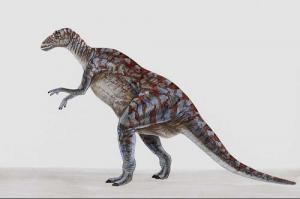 A number of unique fossils of Edmontosaurus have been found, including a partially mummified fossil with food contents in the gut region, and skin impressions.
A number of unique fossils of Edmontosaurus have been found, including a partially mummified fossil with food contents in the gut region, and skin impressions.
Edmontosaurus was a large hadrosaur, or duckbilled dinosaur. Like most other hadrosaurs, this animal had a toothless beak, with teeth further back in the cheeks. These teeth were arranged in a manner that allowed them to remain sharp by sliding back and forth against each other.
The skull shows signs that Edmontosaurus may have had large inflatable flaps of skin near its nose, perhaps used to attract a mate, or to make a loud honking noise.
- What is this dinosaur’s name? Edmontosaurus
- How do I pronounce it? Ed-mon-toe-sore-uss
- What does its name mean? Lizard of Edmonton, Alberta
- How long was this dinosaur? 42.00 feet, 13.00 meters
- How heavy was this dinosaur? 8000.00 pounds
- What class was this dinosaur assigned to? Ornithopoda
- What did this dinosaur eat? Plants
- How many years ago did this dinosaur live? 75,000,000 Years Ago
- In what period did this dinosaur live? Late Cretaceous
- Where did this dinosaur live? North Dakota, Alberta, Colorado, Montana, North America, Saskatchewan, South Dakota, Wyoming
Gryposaurus
Gryposaurus was discovered and named in 1913 by famous paleontologist Lawrence Lambe. The fossils which were first found in Alberta, Canada consist of a number of skull piees, and many skin impressions.
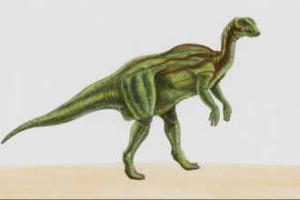 These skin impressions show that Gryposaurus’ skin was covered in small polygon shaped scales.
These skin impressions show that Gryposaurus’ skin was covered in small polygon shaped scales.
The name Curvey Nose refers to the high bump that appears on the front end of its nose.
Gryposaurus was a typical hadrosaur, or duckbilled dinosaur. The name duckbill referes to the duck-like flat bill that these dinosaurs have. This bill is completely toothless. However, Gryposaurus did have teeth further back in its mouth.
- What is this dinosaur’s name? Gryposaurus
- How do I pronounce it? Grip-owe-sore-uss
- What does its name mean? Curvey-Nosed Lizard
- How long was this dinosaur? 30.00 feet, 9.00 meters
- How heavy was this dinosaur? 6000.00 pounds
- What class was this dinosaur assigned to? Ornithopoda
- What did this dinosaur eat? Plants
- How many years ago did this dinosaur live? 75000000 Years Ago
- Where did this dinosaur live? Alberta, Argentina, North America, South America
Hadrosaurus
Hadrosaurus was first discovered in 1838. However, it was not fully studied until 20 years later in 1858, when a vacationing scientist realized how important the discovery was. This makes it one of the very first dinosaurs to be named in North America.
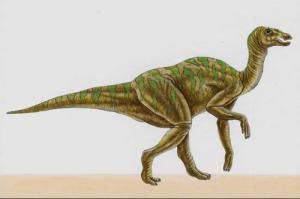 Many later and similar dinosaur discoveries have subsequently been grouped together and called Hadrosaurs, or duckbills. Little is known about Hadrosaurus itself, since the fossil remains were scant. It is believed that Hadrosaurus did not have a crest like those common among so many other duckbills.
Many later and similar dinosaur discoveries have subsequently been grouped together and called Hadrosaurs, or duckbills. Little is known about Hadrosaurus itself, since the fossil remains were scant. It is believed that Hadrosaurus did not have a crest like those common among so many other duckbills.
- What is this dinosaur’s name? Hadrosaurus
- How do I pronounce it? Had-roe-sore-uss
- What does its name mean? Bulky Lizard
- How long was this dinosaur? 33.00 feet, 10.00 meters
- How heavy was this dinosaur? 6000.00 pounds
- What class was this dinosaur assigned to? Ornithopoda
- What did this dinosaur eat? Plants
- How many years ago did this dinosaur live? 85,000,000 Years Ago
- In what period did this dinosaur live? Late Cretaceous
- Where did this dinosaur live? New Jersey, North America
Hypacrosaurus
Living during the Late Cretaceous Period Hypacrosaurus was a typical hadrosaur. A hadrosaur was a dinosaur with a duckbill, which is why they are commonly called duckbilled dinosaurs.
The front of Hypacrosaurus’ mouth began with a toothless bill, followed by rows of self-sharpening teeth located further back in the mouth near the animal’s cheeks. How did these teeth self-sharpen? The top teeth were set in the animal’s mouth at an angle to the bottom teeth that caused them to grind against each other.
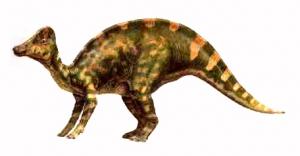 The tail of Hypacrosaurus was very long, and stiff. It would have been used as a weight to balance the animal as it darted quickly from side to side evading predators. Like many other duckbills Hypacrosaurus had a hollow crest located on the top of its head. It is believed that these crests were used to make loud horn blasts that could have been heard from a reasonable distance.
The tail of Hypacrosaurus was very long, and stiff. It would have been used as a weight to balance the animal as it darted quickly from side to side evading predators. Like many other duckbills Hypacrosaurus had a hollow crest located on the top of its head. It is believed that these crests were used to make loud horn blasts that could have been heard from a reasonable distance.
Hypacrosaurus had large eyes compared to other dinosaurs. These keen eyes were probably used to detect enemies like Tyrannosaurus.
- What is this dinosaur’s name? Hypacrosaurus
- How do I pronounce it? High-pah-kroe-sore-uss
- What does its name mean? Near-Top Lizard
- How long was this dinosaur? 30.00 feet, 9.00 meters
- How heavy was this dinosaur? 6000.00 pounds
- What class was this dinosaur assigned to? Ornithopoda
- What did this dinosaur eat? Plants
- How many years ago did this dinosaur live? 70,000,000 Years Ago
- In what period did this dinosaur live? Late Cretaceous
- Where did this dinosaur live? Alberta, Montana, North America
Lambeosaurus
Lambeosaurus was a massive and very important hadrosaur or duckbilled dinosaur. First, at 49 feet in length, it was quite possibly the largest of all the hadrsaurs. Secondly, Lambeosaurus lends its name to the lambeosaurine sub-group of hadrosaurs, or the hadrosaurs with prominent head crests.
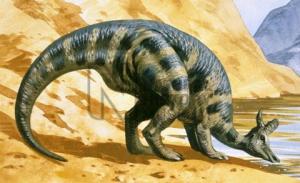 The crest found on Lambeosaurus itself was rectangular, and looked as though a hatchet or axe had lodged in the animal’s head. One unique fossil shows an imprint of Lambeosaurus’ skin, revealing a thick leathery rough hide.
The crest found on Lambeosaurus itself was rectangular, and looked as though a hatchet or axe had lodged in the animal’s head. One unique fossil shows an imprint of Lambeosaurus’ skin, revealing a thick leathery rough hide.
- What is this dinosaur’s name? Lambeosaurus
- How do I pronounce it? Lam-bee-oh-sore-uss
- What does its name mean? Lambe’s Lizard (Named For Lawrence Lambe)
- How long was this dinosaur? 50.00 feet, 15.00 meters
- How heavy was this dinosaur? 12000.00 pounds
- What class was this dinosaur assigned to? Ornithopoda
- What did this dinosaur eat? Plants
- How many years ago did this dinosaur live? 70000000 Years Ago
- Where did this dinosaur live? Alberta, Mexico, North America
Maiasaura
Around 75 million years ago, in a part of the Earth that is now Montana a group of possibly hundreds of Maiasaura dinosaurs were quietly attending their nests. It is believed that these dinosaurs stayed together in nesting herds, much as modern birds often do today. As the dinosaurs played, cared for their young, and watched for danger, an unexpected natural disaster caused the entire heard to be buried in volcanic ash.
 This event helped to fossilize many different animals, including adults, young, and even unhatched eggs. X rays show that the eggs actually contain fossilized embryos that were in the process of developing. Maiasaura had a long narrow snout very similar to that of modern-day horses. Above each eye was a small crest-like horn. Maiasaura was a hadrosaur, or duckbill, but lacked the head crest common on so many other duckbills.
This event helped to fossilize many different animals, including adults, young, and even unhatched eggs. X rays show that the eggs actually contain fossilized embryos that were in the process of developing. Maiasaura had a long narrow snout very similar to that of modern-day horses. Above each eye was a small crest-like horn. Maiasaura was a hadrosaur, or duckbill, but lacked the head crest common on so many other duckbills.
- What is this dinosaur’s name? Maiasaura
- How do I pronounce it? My-yah-sore-ah
- What does its name mean? Good Mother Lizard
- How long was this dinosaur? 29.50 feet, 9.00 meters
- How heavy was this dinosaur? 8000.00 pounds
- What class was this dinosaur assigned to? Ornithopoda
- What did this dinosaur eat? Plants
- How many years ago did this dinosaur live? 75,000,000 Years Ago
- In what period did this dinosaur live? Late Cretaceous
- Where did this dinosaur live? Montana, North America
Parasaurolophus
Parasaurolophus was discovered in Alberta, Canada in 1922 by William Parks. This dinosaur was a typical hadrosaur or duckbilled dinosaur, with a toothless bill, rows of cheek teeth, powerful rear legs, and a prominent head crest.
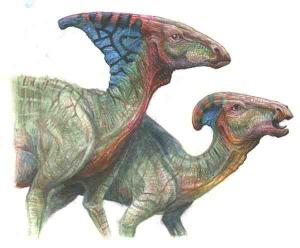 Scientists believe that Parasaurolophus used this crest like a horn, allowing it to make very loud calls to distant companions. The fossils found in Alberta were fairly complete, and consisted of an almost complete skeleton.
Scientists believe that Parasaurolophus used this crest like a horn, allowing it to make very loud calls to distant companions. The fossils found in Alberta were fairly complete, and consisted of an almost complete skeleton.
- What is this dinosaur’s name? Parasaurolophus
- How do I pronounce it? Parah-sore-owe-loaf-uss
- What does its name mean? Ridged Lizard
- How long was this dinosaur? 40.00 feet, 12.00 meters
- How heavy was this dinosaur? 6000.00 pounds
- What class was this dinosaur assigned to? Ornithopoda
- What did this dinosaur eat? Plants
- How many years ago did this dinosaur live? 70,000,000 Years Ago
- In what period did this dinosaur live? Late Cretaceous
- Where did this dinosaur live? Alberta, North America
Prosaurolophus
In 1912 a medium sized hadrosaur, or duckbilled dinosaur was described and named Prosaurolophus by Barnum Brown. This animal lived about 75 million years ago on the North American Continent.
Prosaurolophus used its powerful hind legs to walk bipedally, leaving its front legs and feet to be used in self defense, and to assist in feeding. Fossilized tracks show that Prosaurolophus could also run on all four legs when needed.
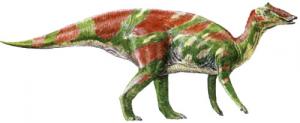 This duckbill did not have the head crest common on many of its close relatives. Instead a small Crest appeared just above its eyes. Like most duckbills, Prosaurolophus had a toothless bill in the front of its mouth, with teeth located further back in its cheeks.
This duckbill did not have the head crest common on many of its close relatives. Instead a small Crest appeared just above its eyes. Like most duckbills, Prosaurolophus had a toothless bill in the front of its mouth, with teeth located further back in its cheeks.
- What is this dinosaur’s name? Prosaurolophus
- How do I pronounce it? Proe-saw-oh-loaf-uss
- What does its name mean? Before Saurolophus
- How long was this dinosaur? 26.50 feet, 8.00 meters
- How heavy was this dinosaur? 4000.00 pounds
- What class was this dinosaur assigned to? Ornithopoda
- What did this dinosaur eat? Plants
- How many years ago did this dinosaur live? 75,000,000 Years Ago
- In what period did this dinosaur live? Late Cretaceous
- Where did this dinosaur live? Alberta, Montana, North America
Protohadros
The dinosaur Protohadros appeared on the Earth around 95 million years ago. This was a time of warmth and ample vegetation on the Earth. Protohadros was a hadrosaur, or duckbilled dinosaur. It possessed a long duck-like beak, which contained no teeth. Further back within its mouth were rows of possibly thousands of small teeth, which it used to crush plant material before swallowing it.
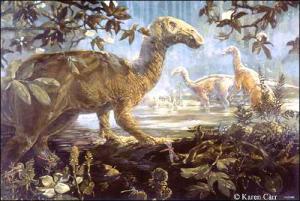 Scientists believe that Protohadros, which was discovered in 1994 by Gary Byrd could have been the ancestor for all the other duckbilled dinosaurs. If not the ancestor, it was certainly one of the first. Protohadros had powerful hind legs, which it used for quick movement. The front legs were smaller and weaker. both front and rear legs ended in hoof-like claws.
Scientists believe that Protohadros, which was discovered in 1994 by Gary Byrd could have been the ancestor for all the other duckbilled dinosaurs. If not the ancestor, it was certainly one of the first. Protohadros had powerful hind legs, which it used for quick movement. The front legs were smaller and weaker. both front and rear legs ended in hoof-like claws.
- What is this dinosaur’s name? Protohadros
- How do I pronounce it? Proe-toe-had-ross
- What does its name mean? Early Duckbilled Lizard
- How long was this dinosaur? 19.00 feet, 6.00 meters
- How heavy was this dinosaur? 2000.00 pounds
- What class was this dinosaur assigned to? Ornithopoda
- What did this dinosaur eat? Plants
- How many years ago did this dinosaur live? 95000000 Years Ago
- Where did this dinosaur live? North America, Texas
Saurolophus
About 70 million years ago, Saurolophus roamed the Asian and North American Continents. Like many other hadrosaurs, or duckbills this medium sized dinosaur an elaborate head crest.
There is much debate among scientists today about what this crest was used for. In the early days of dinosaur discovery, it was thought that duckbills were water animals, and that these crests may have been snorkels for breathing underwater.
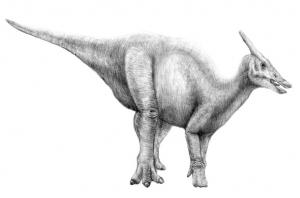 Today it is thought that they may have been used as horns to make loud honk noises, making duckbills among the loudest of all the dinosaurs. Fossil evidence shows that Saurolophus might have had a large flap of skin on its head that could possibly have been inflated like a giant balloon in order to attract a mate.
Today it is thought that they may have been used as horns to make loud honk noises, making duckbills among the loudest of all the dinosaurs. Fossil evidence shows that Saurolophus might have had a large flap of skin on its head that could possibly have been inflated like a giant balloon in order to attract a mate.
- What is this dinosaur’s name? Saurolophus
- How do I pronounce it? Sore-owe-loaf-uss
- What does its name mean? Crested Lizard
- How long was this dinosaur? 33.00 feet, 10.00 meters
- How heavy was this dinosaur? 4000.00 pounds
- What class was this dinosaur assigned to? Ornithopoda
- What did this dinosaur eat? Plants
- How many years ago did this dinosaur live? 70000000 Years Ago
- Where did this dinosaur live? Asia, Mongolia, North America
Shantungosaurus
Shantungosaurus lived in Asia around 80 million years ago. This large hadrosaur, or duckbill was possibly the largest of all the duckbilled dinosaurs to have roamed the Earth.
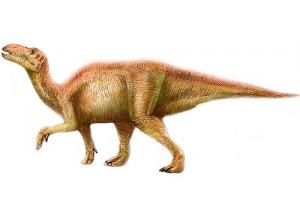 It was discovered and named in 1973. Since that time, a total of five individuals have been discovered, giving scientists a pretty good idea of what this animal looked like. Like many other hadrosaurs, Shantungosaurus had a very long, tapering tail, which it would have used to balance itself as it ran, and also as a possible weapon. Tendons within the tail made it stout, and inflexible.
It was discovered and named in 1973. Since that time, a total of five individuals have been discovered, giving scientists a pretty good idea of what this animal looked like. Like many other hadrosaurs, Shantungosaurus had a very long, tapering tail, which it would have used to balance itself as it ran, and also as a possible weapon. Tendons within the tail made it stout, and inflexible.
Like other duckbills, Shantungosaurus had no teeth in the front of its mouth, and several rows of self-sharpening teeth in the cheek region.
- What is this dinosaur’s name? Shantungosaurus
- How do I pronounce it? Shandong Lizard (Location of Discovery)
- What does its name mean? Shahn-dung-owe-sore-uss
- How long was this dinosaur? 50.00 feet, 15.00 meters
- How heavy was this dinosaur? 10000.00 pounds
- What class was this dinosaur assigned to? Ornithopoda
- What did this dinosaur eat? Plants
- How many years ago did this dinosaur live? 78,000,000 Years Ago
- In what period did this dinosaur live? Late Cretaceous
- Where did this dinosaur live? Asia, China
